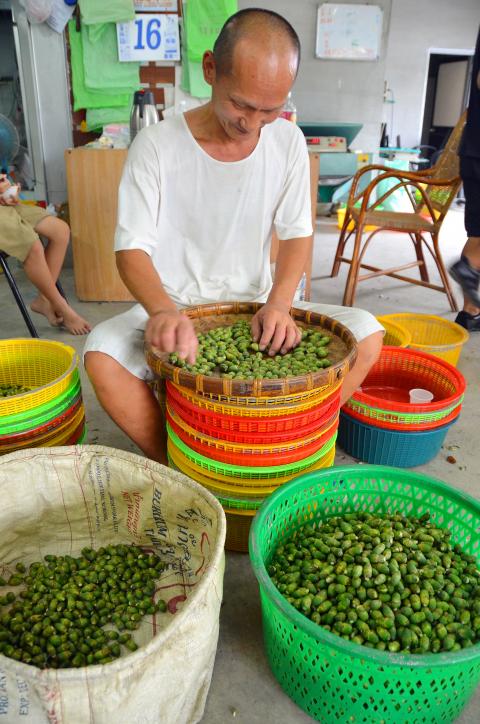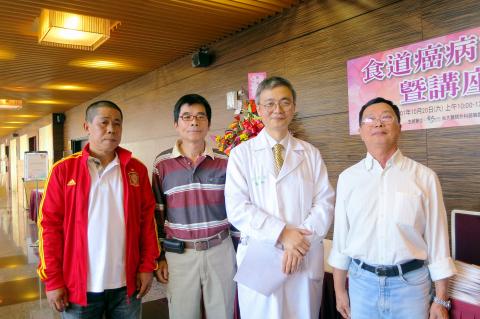Over the past two decades, there has been an increase in the prevalence of esophageal cancer in Taiwan and the number of attributable deaths has also risen significantly. Doctors are ascribing the spike in cases and deaths to males smoking tobacco, drinking alcohol and chewing betel nuts. On Oct. 22, National Taiwan University Hospital’s (NTUH) Department of Thoracic Surgery established the Esophageal Cancer Association. They are urging people who might be at risk to receive checkups periodically.
Lee Chang-ming, head of NTUH’s Department of Thoracic Surgery, says that esophageal cancer typically occurs among males in their 50s and 60s. Esophageal cancer was sixth on a list of the top 10 most common cancer-related causes of death in Taiwan last year for males. The average age of people dying from the cancer has gradually fallen, decreasing from 64 in 2001 to 58 last year. The age of people dying from esophageal cancer can be as low as 25 to 29 years old. The youngest person that Lee ever treated for esophageal cancer was 31 years old, he says.
People are two to three times more likely to get esophageal cancer if they chew 10 betel nuts every day for 10 years, Lee says. The same goes for people who smoke a pack of cigarettes every day for 10 years. However, if that sort of risky behavior combines smoking cigarettes, drinking alcohol and chewing betel nuts, the chances of getting the cancer increase exponentially, meaning a person is 20 to 60 times more likely to get it. If you enjoy eating hot soup and pickled foods, which can be high in nitrosamines, a carcinogen, or if your esophagus has been damaged and you have a family history of esophageal cancer, you should get tested regularly.

Photo: Yeh Yung-chien, Liberty Times
照片:自由時報記者葉永騫
Lee says that because it is difficult to detect the cancer at an early stage, it makes it necessary to use an upper gastrointestinal endoscopy for a diagnosis. Once symptoms, including difficulty breathing, pain and a hoarse, cracked voice appear, it means that the cancer has probably already progressed to the point where it would require surgery, chemotherapy and radiation therapy.
(Liberty Times, Translated by Kyle Jeffcoat)
近二十年來,台灣的食道癌盛行率不僅提高,死亡率也逐年攀升,醫師認為,與男性抽菸、喝酒、嚼檳榔有關。台大醫院胸腔外科十月二十日成立「食道癌病友會」,呼籲有危險因子者應定期檢查。

Photo: Chung Li-hua, Liberty Times
照片:自由時報記者鍾麗華
台大醫院胸腔外科主任李章銘說,食道癌好發在五、六十歲以上的男性,去年男性十大癌症死因排名中,食道癌位居第六位,因食道癌死亡年齡從二00一年六十四歲,下降到去年的五十八歲,有逐漸年輕化趨勢,因食道癌死亡的年齡甚至落在二十五至二十九歲。他在臨床上遇到罹患食道癌的最年輕患者僅三十一歲。
李章銘說,每天嚼十顆檳榔達十年,罹患食道癌機率大約增加二到三倍;每天抽一包菸達十年,罹癌機率也增加二到三倍;若菸、酒加檳榔,罹癌機率將增二十到六十倍。此外,若喜歡喝熱湯、愛吃醃漬等含亞硝基胺類的食物,以及食道曾受損,或有家族史等危險因子,都應定期接受檢查。
李章銘指出,由於食道癌早期發現不易,必須透過上消化道胃鏡檢查才能做早期診斷,但當吞嚥困難、疼痛、聲音沙啞等症狀出現,食道癌已非早期,只能開刀、化療及放射線治療。
(自由時報記者鍾麗華)

In an effort to fight phone scams, British mobile phone company O2 has introduced Daisy, an AI designed to engage phone con artists in time-wasting conversations. Daisy is portrayed as a kindly British granny, exploiting scammers’ tendency to target the elderly. Her voice, based on a real grandmother’s for authenticity, adds to her credibility in the role. “O2” has distributed several dedicated phone numbers online to direct scammers to Daisy instead of actual customers. When Daisy receives a call, she translates the scammers’ spoken words into text and then responds to them accordingly through a text-to-speech system. Remarkably, Daisy

Bilingual Story is a fictionalized account. 雙語故事部分內容純屬虛構。 Emma had reviewed 41 resumes that morning. While the ATS screened out 288 unqualified, she screened for AI slop. She could spot it a mile away. She muttered AI buzzwords like curses under her breath. “Team player.” “Results-driven.” “Stakeholder alignment.” “Leveraging core competencies.” Each resume reeked of AI modeling: a cemetery of cliches, tombstones of personality. AI wasn’t just changing hiring. It was draining the humanity from it. Then she found it: a plain PDF cover letter. No template. No design flourishes. The first line read: “I once tried to automate my

Every May 1, Hawaii comes alive with Lei Day, a festival celebrating the rich culture and spirit of the islands. Initiated in 1927 by the poet Don Blanding, Lei Day began as a tribute to the Hawaiian custom of making and wearing leis. The idea was quickly adopted and officially recognized as a holiday in 1929, and leis have since become a symbol of local pride and cultural preservation. In Hawaiian culture, leis are more than decorative garlands made from flowers, shells or feathers. For Hawaiians, giving a lei is as natural as saying “aloha.” It shows love and

1. 他走出門,左右看一下,就過了馬路。 ˇ He walked outside, looked left and right, and crossed the road. χ He walked outside and looked left and right, crossed the road. 註︰並列連接詞 and 在這句中連接三個述語。一般的結構是 x, y, and z。x and y and z 是加強語氣的結構,x and y, z 則不可以。 2. 他們知道自己的弱點以及如何趕上其他競爭者。 ˇ They saw where their weak points lay and how they could catch up with the other competitors. χ They saw where their weak points lay and how to catch up with the other competitors. 註:and 一般連接同等成分,結構相等的單詞、片語或子句。誤句中 and 的前面是子句,後面是不定詞片語,不能用 and 連接,必須把不定詞片語改為子句,and 前後的結構才相等。 3. 她坐上計程車,直接到機場。 ˇ She took a cab, which took her straight to the airport. ˇ She took a cab and it took her straight